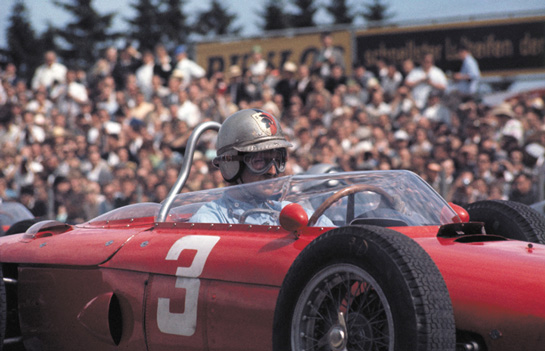
Count Wolfgang von Trips in the Ferrari 156 at the start of the 1961 Nurburgring. Photo by Robert Daley, author of “The Cruel Sport”.
Order from: Motorbooks (www.motorbooks.com)
[After Wyss obtained “Real Racers: Formula 1 Racing in the 1950s and 1960s: A Driver’s Perspective” for review, he thought it so good the Editor ended up ordering another copy for self. The following conversation about the book then became the review. Right up front we can say that we both think it’s a great book and an even better deal at only $40, plus the 30% MBI is offering with the special code you will find at the end of this review brings it down to $28 plus shipping for a limited time—Ed.]
Wyss: Those who see the title “Real Racers” might be put off if they are not Formula I fans, as it automatically implies that only these racers, out of all the types of drivers, were the “real racers.”
Ed: Real Racers implies that today’s drivers are perhaps lesser beings, less brave less macho than the Formula 1 drivers of the 50 and 60s (much less the even more heroic drivers of previous eras). The term “real racers” combined with “Formula 1” also discounts the dangers of Indianapolis, where more drivers lost their lives than on any Formula 1 track.
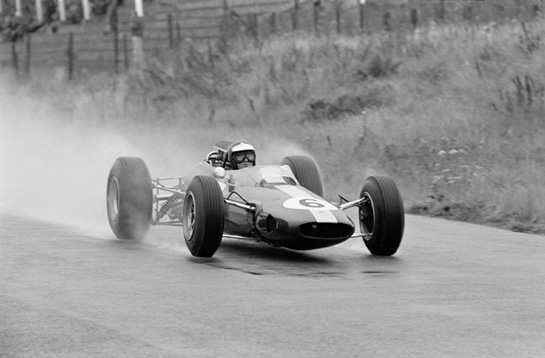
Jim Clark at Zandvoort, 1965. He won in his usual domineering fashion, but the racing world was shocked when he lost his life at an F2 event at Hockenheim in 1968. Photo by Yves Debraine.
Wyss: It would be interesting to find out if our readers think that today’s drivers are less brave than those who raced in the fifties and sixties.
Ed: Let’s give them some stats. A fairly accurate number of drivers killed from 1946 to 1963 was compiled by Peter Miller for the book, “The Fast Ones”. Miller listed 176 drivers from all forms of organized motorsport. We can’t just count the F1 deaths, because in those days drivers would drive in rallys, stock car races, Formula 2 and 3, as well as a full schedule of sportscar races. There were many more deaths for them to deal with other than those which occurred during a Formula 1 event. They buried their dead a lot more often, and it must have had a huge psychological impact on the drivers.
In another 17 year period, from 1994 to 2011, there were zero deaths in Formula 1.
There’s a very fine line between bravery and stupidity. They’re almost the same thing. Sometimes they are the same thing… Sir Stirling Moss
But does this make today’s drivers unreal eunuchs? David Coulthard, writing the Forward to the book, thinks that today’s drivers are no less brave, but need to be brave less often. “Driving a Formula 1 car is still the ultimate thrill…[Back then] those thrills more often bore the risk of the ultimate price, The drivers of the day weren’t foolhardy; they knew the risks, That’s why, then as now, they did what they did.” We only need to remind ourselves of Massa’s near fatal accident in 2009 to realize that the risk of death is still close at hand. But will our readers agree?
Wyss: Those of us who attend vintage racing and prefer the race cars of yore rather than the race cars of modern racing relish books that show what drivers, cars and tracks looked like in what I like to think is “racing’s golden years” –before the drivers wore full face helmets and you could hardly recognize them, which is the situation today.
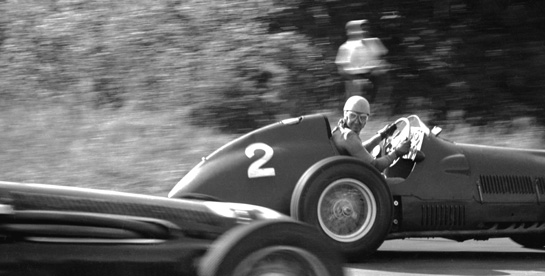
Alberto Ascari glances over his shoulder at the Alfa Romeo of (probably) Juan Fangio at Monza in 1951. The two were locked in battle for the championship. Photo by Louis Klemantaski.
Ed: That that is the real essence of this book—to tell what it was like in those days via quotes from those still around to tell the tales.accompanied by absolutely stunning photography. what is was like in that “golden era”. (Frank Williams, however, doesn’t pine over those days). The gifted Louis Klemantaski is just one of the masters between the covers—Peter Coltrin, Gunther Molter, Yves Debraine, Alan Smith, and Ami Guichard are all represented, many in full color, a real rarity for those years.
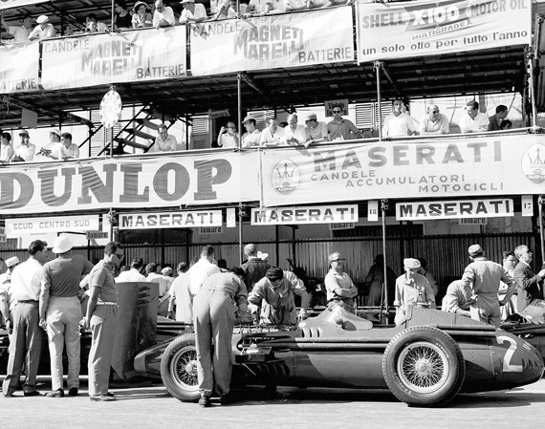
Just a beautiful day for a motor race: Pescara, 1957, and Fangio’s curvaceous 250F contrasts perfectly with the rectangular banners and signs. One of our favorite images, by Edward Eves.
Wyss: The book is divided into sections, not race by race but under such titles as The Players, Arrival, Practice, The Start, Racecraft, Finesse, Velocity, Crashes and The Finish. I would have thought the usual way is to do it chronologically, such as “Tasman series Warwick Farm Feb. ‘67”, but it makes sense the way he did it. The Crashes chapter doesn’t have as many crash and burn shots as I worried about, but the shot of Mike Taylor’s Lotus at the ’60 Belgian GP is sobering as the car is broken up in the trees.
Today’s drivers are no less brave, but need to be brave less often…The Editor
Really scary are the black and whites at the ’69 Spanish GP as people run out on the track to help Graham Hill after a crash. The sole burning shot is Bandini’s crash, thankfully shot at far enough a distance that we don’t see the blackened corpse.
Ed: The organization at first seems odd, but it works out. There are lumps and bumps in the narrative, but the quality of the photos offsets any negatives.
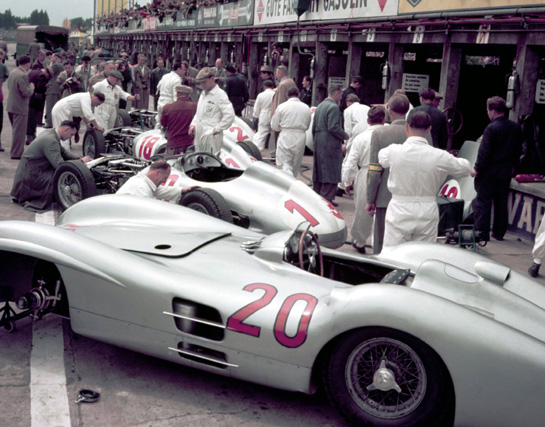
Another shot from Yves Debraine. Nurburgring 1954, the might of the Mercedes Benz team out in force. Number 20 would be driven by Hans Hermann. One of the streamliners is on display at the Indianapolis Museum: the car is absolutely beautiful and must be seen to be appreciated.
Wyss: The real joy in this book is the close-up pictures of your favorite Grand Prix drivers like Moss, Brabham Graham Hill, McLaren, etc. Each set of pictures is accompanied by a section of text with biographical details. There are many personal quotes, mini-interviews in effect, which add to your appreciation of the pictures. The author gives most of the racers equal-sized biographical data, even though the data on starts vs. wins are a bit shocking at times when you realize that even a driver the caliber of Pedro Rodriguez had 54 GP starts but only two wins—and many listed in the book have no wins at all!
Ed: The author, Stuart Codling, who was born just yesterday (in 1972, just about when his book ends!) interviewed Moss, Brabham, Stewart, Surtees, and Frank Williams (all are Sirs, btw, aside from Surtees), the only ones who were left to tell the tales. The text also includes relevant quotes from the deceased Graham Hill and Bruce McLaren, By and large however, Moss gives not only the most comments but the most telling comments. His father demanded he wear a helmet. “’But Dad, that’s a bit sissy”, said son. His attitude remains the same and in stark contrast to Stewart. “One of the reasons I raced was that it was dangerous. It was an important ingredient,” wrote Moss.
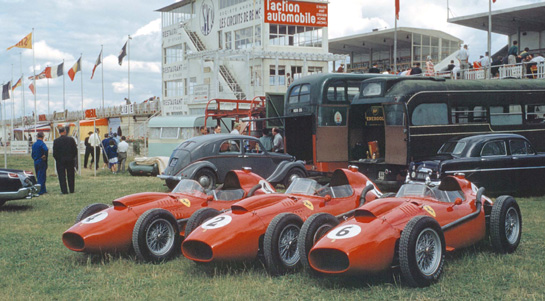
Arrival photos were refreshing and natural. Here the entire Ferrari team is parked nonchalantly on the grass. A Lancia Aprilia in the background ads to this Peter Coltrin image from Reims in 1958.
Wyss: The shots I enjoyed the most are in the section called The Arrival where the cars are still spic and span clean and the spectators are right up next to the cars. Try to get up next to the cars at modern day GP races! The pictures of the Mercedes W196 streamliner are really interesting, because I have never seen good shots of that full fendered car before—and wonder was there no rule that a GP car have open wheels?
Ed: We both enjoyed the Arrival section best. I think for two reasons: Few of these have been published; magazines of the era in general only published action shots. Second, the cars were out in the open, available for anyone to see, and more often than not, they were in a green paddock, under trees in a more natural setting. The cars almost blended with nature, because they were designed with beauty as well as function.
Wyss: Other great shots are of the cars at speed. They show how some Champions could drive with such ease. Thereuse it ’s one of Fangio in a 250F taken at speed, and in it he looks so relaxed you can hardly believe he is moving at great speed. There’s an equally great one of Moss in a W196 looking so relaxed he looks as if he is asleep! Another favorite shot is the one in which significant people in racing are just shooting the breeze, such as the one of Carlo Chiti and Phil Hill taking to Dan Gurney while they stand next to the Ferrari entries at the ’59 Portuguese GP. It’s great to see these drivers who some of us only remember as older men back when they were brave young men in the prime of life. In the chapter called The Finish, a shot of Fangio at the ’56 Syracuse GP is a great one with the driver wearing floral laurels. The shot of Tony Brooks at the ’57 Monaco Grand Prix—his face covered with soot—is more telling in showing the reader how hard even a second place finish is sometimes won.
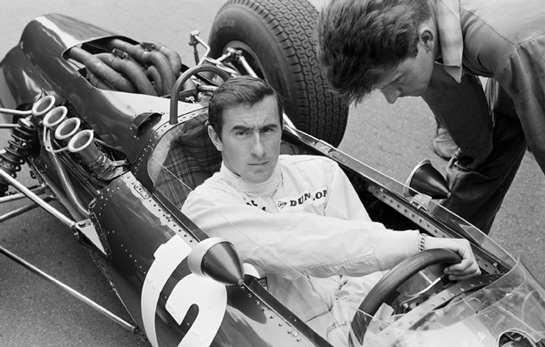
Jackie Stewart seemingly unhappy with either the car or photographer. His accident with a BRM would start his crusade for driver safety.
Ed: Upon receiving my copy, I quickly paged through the book and listed the photos that really impressed. I tried to be very selective but still came up with about 30 superb images that really rang my bell. Overall, there are about 226 photos, both black and white and in color. A day later, having read the text, we still chose 16 of the original 30. And there is nothing wrong with the remaining 210 either. I’ve seen perhaps a quarter of the photos elsewhere, but that’s a small number overall. The rest are fresh and intriguing.
Wyss: I applaud Peter Sachs for buying the Klemantaski Collection in the first place and in making this art available so newer generations can see what they missed from the “golden era.”
Ed: Collections like Sachs’ need to be shared. What wonders, what art, what history is buried in the Klemantaski collection! To our great fortune, Sachs is one who does share—Real Racers is but one of the many books published via the Collection.
Photo collection books tend to sit on the shelves longer than, say, marque histories, but anyone who wants to know what the fifties and sixties were like, both from great photos and narratives, can’t go wrong with this book. At only $40 this is an inexpensive walk through history and art.
All of the photos in the book are available as prints from www.klemcoll.com We checked to see what one of our favorite photos would cost, and we found that a black and white 8×10 is $65, 11×14 $200 and a 16×20 $300. It is the same price for a color print.
About the author of “Real Racers”
Journalist and broadcaster Stuart Codling has worked in motorsports for over a decade, covering sports cars in the United States before joining F1 Racing, the world’s biggest-selling Formula 1 magazine, in 2001. He has ridden pillion with World Superbike Champion Neil Hodgson, gone snowboarding with (former) FIA President Max Mosley, and been sworn at by sometime Ferrari F1 driver Eddie Irvine. He has appeared as an F1 expert on TV and radio, hosted for Renault F1, and contributes to F1 Racing, Autosport, Autocar, and the Red Bulletin. He is the author of the Motorbooks bestseller Art of the Formula 1 Race Car and lives in Farnham, Surrey, England.
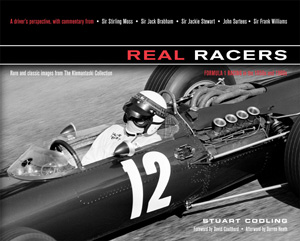
Real Racers: Formula 1 Racing in the 1950s and 1960s: A Driver’s Perspective. By Stuart Codling
Foreword by David Coulthard
ISBN-13: 9780760338919
$40 US; $27.50 UK; $44 CAN
Binding: Hardcover (12.25 x 10)
Page count: 208 Pages
Images: 50 Color / 176 Black & White
Order from: Motorbooks (www.motorbooks.com)
Special Discount code, worth 30 %! VEL2011
Wallace Wyss is editing his Ferrari detective novel which will make its debut at Monterey in August, 2011.
Pete Vack is the Editor and Publisher of VeloceToday.com.
Is it true sensitivity or political correctness that these days racing reviewers and commenters express such concern over photos of fatalities? Is seeing a pic of a dead driver or spectator any better or worse than the innumerable repetitions of the movie clip of G.I.s being shot coming ashore on D-Day or bodies washing back and forth in the waves hitting the beach? The newsreel of Vukovich’s death at Indy in ’55, the Sachs/McDonald fireball, Swede Savage flipping over and over down the track, minus most of his car–they were shown again and again. We all winced and said “That was awful” and went on with our lives. Ah well; things change.
From one of the reviewers:
It’s a tough call; I like to see old racing photos but I don’t want to see the immediate aftermath of a crash; (the worse imaginable being a driver trapped in a burning car.)
Not that it would turn me away from being a fan of car racing; it just that it bursts the illusion that you can cheat death and get away with it time and time again. The book depicts that era of innocence when there were no flameproof driving suits, no Nomex gloves, no full coverage helmets; some of the drivers look like they are about to play golf, not go 150 mph in a car without seatbelts. I think in picture selection the author struck the right balance between showing the devil-may-care nonchalance of the drivers back then with a small intimation of the dangers that were just around the corner, literally and figureatively.